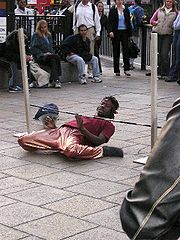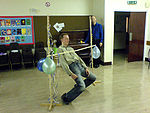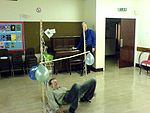.gif)
Limbo (dance)
Encyclopedia

Dance
Dance is an art form that generally refers to movement of the body, usually rhythmic and to music, used as a form of expression, social interaction or presented in a spiritual or performance setting....
that originated on the island of Trinidad
Trinidad
Trinidad is the larger and more populous of the two major islands and numerous landforms which make up the island nation of Trinidad and Tobago. It is the southernmost island in the Caribbean and lies just off the northeastern coast of Venezuela. With an area of it is also the fifth largest in...
. The dancer moves to a Caribbean rhythm, then leans backward and dances under a horizontal pole without touching it. Upon touching it or falling backwards, the dancer is "out". When several dancers compete, they travel in single file, and the stick is gradually lowered until only one dancer — who has not touched either the pole or the floor — remains.
In Jamaica, the trendy limbo music of the 1950s was often based on a clave rhythm
Clave (rhythm)
The clave rhythmic pattern is used as a tool for temporal organization in Afro-Cuban music, such as rumba, conga de comparsa, son, son montuno, mambo, salsa, Latin jazz, songo and timba. The five-stroke clave pattern represents the structural core of many Afro-Cuban rhythms...
. It is also widely heard in Jamaican mento
Mento
Mento is a style of Jamaican folk music that predates and has greatly influenced ska and reggae music. It has its roots in calypso and other Jamaican folk music. Mento typically features acoustic instruments, such as acoustic guitar, banjo, hand drums, and the rhumba box — a large mbira in the...
recorded in the 1950s, in songs such as "Limbo" by Lord Tickler and Calypsonians or "Limbo" by Denzil Laing & the Wrigglers, as well as many others songs not directly related to the limbo dance theme.
In recent years, limbo dancing has been conducted as a social "icebreaker
Icebreaker (facilitation)
An icebreaker is a facilitation exercise intended to help a group to begin the process of forming themselves into a team. Icebreakers are commonly presented as a game to "warm up" the group by helping the members to get to know each other...
" game for tourists at Caribbean and other tropical
Tropics
The tropics is a region of the Earth surrounding the Equator. It is limited in latitude by the Tropic of Cancer in the northern hemisphere at approximately N and the Tropic of Capricorn in the southern hemisphere at S; these latitudes correspond to the axial tilt of the Earth...
resort
Resort
A resort is a place used for relaxation or recreation, attracting visitors for holidays or vacations. Resorts are places, towns or sometimes commercial establishment operated by a single company....
s. The winning dancer often receives a prize.
The name comes directly from the Trinidad dialect
Dialect
The term dialect is used in two distinct ways, even by linguists. One usage refers to a variety of a language that is a characteristic of a particular group of the language's speakers. The term is applied most often to regional speech patterns, but a dialect may also be defined by other factors,...
of English
English language
English is a West Germanic language that arose in the Anglo-Saxon kingdoms of England and spread into what was to become south-east Scotland under the influence of the Anglian medieval kingdom of Northumbria...
; Merriam–Webster http://m-w.com/cgi-bin/dictionary?limbo lists the etymology as "English of Trinidad & Barbados; akin to Jamaican English
Jamaican English
Jamaican English or Jamaican Standard English is a dialect of English spoken in Jamaica. It melds parts of both American English and British English dialects, along with many aspects of Irish intonation...
limba to bend, from English limber".
 |
 |
 |

